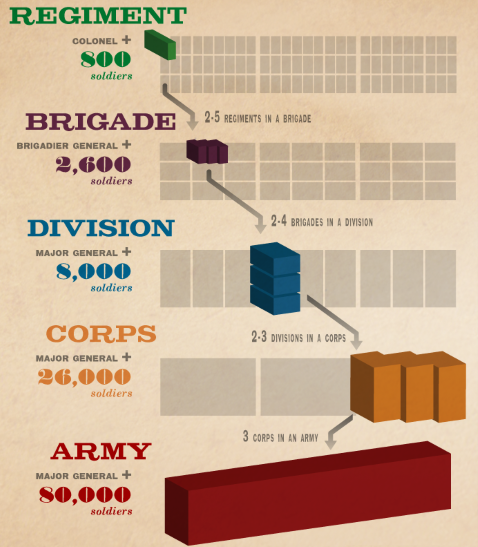The organization and nomenclature for an army can be confusing at times for those unfamiliar. The Cornfield tried to remain historically accurate and precise in the description of army movements, while not letting this interfere with the story. This is a short summary to aid in that regard – briefly explaining the difference between a platoon, company, regiment, brigade, division, and other units of a civil war army.
Most of the military leaders in armies the United States and Confederate States were graduates of the United States Military Academy at West Point, New York, and most were veterans of the United States Army. As a result, both armies were organized in much the same way during the American Civil War.
The basic units of the infantry were the regiment and the company. The company, at least initially, contained 100 men, commanded by a captain. A company typically had two or more lieutenants and up to five sergeants. It was often divided into platoons of up to 30 men, commanded by a lieutenant or sergeant.
The regiment initially consisted of ten companies and slightly over 1,000 men and commanded by a colonel. The others not assigned to a company included senior officers – a lieutenant colonel or major or both, regimental surgeon and staff, regimental chaplain, senior officers’ staff and aides, supply staff, and sometimes even field musicians.
A volunteer regiment was mustered into the army once it achieved these numbers and this organization. Thereafter, a regiment rarely consisted of a thousand men, and a company rarely consisted of a hundred. Death, wounds, disease, and desertion depleted the ranks, and the units became smaller and smaller as the war progressed. Neither army used replacements very often to refill the ranks. New volunteers and draftees were used to form new regiments.
An infantry battalion was not a formal unit in either army. But whenever more than one company, but less than all the companies within a regiment, were separated out for some specific service or mission, the group would be referred to as a battalion, and commanded by a lieutenant colonel or major.
In major battles and other cases where necessary, regiments needed to act in concert with others. In such cases, typically four regiments (although sometimes three or five) were placed with a brigade. A brigade was commanded by a Brigadier General. A brigade could contain as many as 4,000 soldiers, although often much less.

When brigades needed to act in concert with each other, they were placed within a division. There were typically three to five brigades in a division, which was commanded by a Major General.
An army was a group of multiple divisions responsible for a specific area. Both sides gave these geographic names. In our story, Sean was, at times, in the Union Army of the Shenandoah, Army of Virginia and Army of the Potomac. Connor was, at times, in the Confederate Army of the Shenandoah and Army of Northern Virginia.
Large armies sometimes needed further subdivision. The most frequently used was a corps. There is no standard definition of a corps, other than a group of more than one division and less than an “army”. Different army commanders preferred different organizations. The several commanders of the Army of the Potomac preferred multiple corps. General Lee preferred only two or three for the Army of Northern Virginia. Technically, the Confederate army did not authorize the use of “corps” prior to Antietam. Lee used the concept anyway, dividing his army into two “wings” in the Northern Virginia and Maryland campaigns, with one wing commanded by Thomas Jackson and the other by James Longstreet.
The various ranks of commanding officers are sometimes misleading as well. The death, wounds, illness, or temporary absence of a commander often led to a regiment commanded by a major, a brigade by a colonel, and a division by a brigadier general.
Both armies had two ranks above that of major general. The Confederates named five full generals at the start of the war, one of them being Robert E. Lee. They also had the rank of lieutenant general, below that of general and above major general. Jackson and Longstreet both became lieutenant generals.
The Union army only had one lieutenant general, Ulysses S. Grant, promoted from major general in 1864. Grant became a full grade general after the war. He was the first lieutenant general and the first full general in the United States Army since George Washington.
Cavalry regiments, brigades and divisions were organized differently from that of the infantry. Artillery units were typically organized as a battalions or batteries, and typically attached to the infantry at the brigade or division level.
